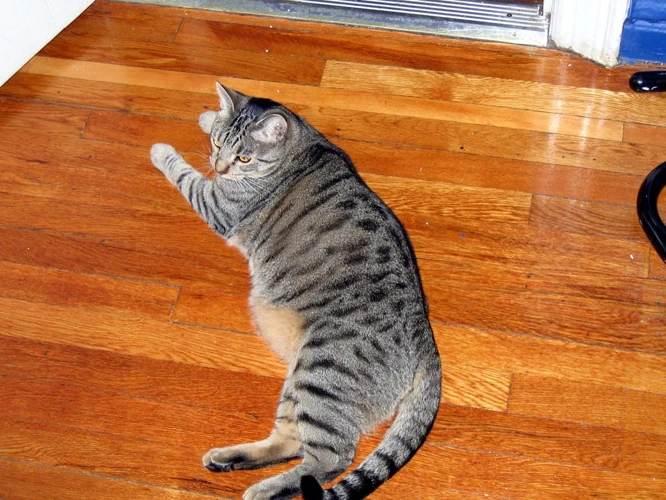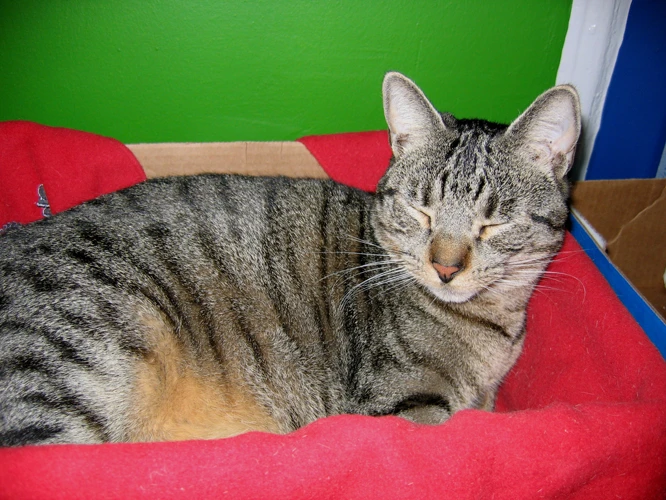It’s no secret that cats are naturally independent creatures. However, did you know that you can teach your California Spangled Cat some fun tricks? Yes, you read that right! With some persistence and patience, teaching your feline friend some new tricks can be a rewarding experience for both you and your cat. In this article, we’ll explore why teaching tricks to your California Spangled Cat is beneficial, share some useful tips for successful teaching, as well as some great trick ideas to get you started. Plus, we’ll discuss some troubleshooting tips if you encounter any issues. Let’s dive in and explore the world of trick-teaching for cats!
Why Teach Tricks to Your California Spangled Cat?

As a cat owner, you might think teaching tricks to your California Spangled cat is unnecessary. However, there are many benefits to taking the time to train your feline friend beyond just preventing unwanted behaviors. Mental stimulation can keep your cat happy and healthy, while bonding during training sessions helps to create a stronger bond between you and your pet. Additionally, impressing friends and family with your cat’s abilities can be a fun and unique experience. Before diving into tricks, it is important to understand the positive reinforcement techniques that work best for training your California Spangled cat.
Mental Stimulation
One of the main reasons to teach tricks to your California Spangled cat is to provide them with mental stimulation. Cats are intelligent animals that need to be mentally engaged to prevent boredom and stimulate their senses. Teaching them new tricks is a great way to provide them with mental exercise and keep them entertained. Interactive play is essential for cats to reduce stress and prevent the development of unwanted behaviors such as aggression and destructive tendencies.
There are many ways to provide mental stimulation for your cat, but trick training is one of the most effective methods. Tricks can be anything from simple commands to more complex behaviors, such as jumping through a hoop or walking on a leash. By keeping your cat engaged in learning new things, you can prevent them from becoming bored and uninterested in their surroundings.
The mental stimulation provided by trick training can also improve your cat’s cognitive abilities. Training can improve their memory, problem-solving skills, and cognitive flexibility. It is a great way to keep them mentally sharp and can even prevent cognitive decline in older cats.
If your cat is indoors most of the time, trick training is an excellent way to provide them with stimulation and prevent boredom. It gives cats a sense of purpose, helping them feel as though they are contributing to their household. Trick training sessions can help you to bond with your cat. As you spend time training together, you will develop a stronger bond and understanding of one another.
Teaching tricks to your California Spangled cat has many benefits, including providing mental stimulation, improving cognitive abilities, and preventing unwanted behaviors. Trick training is a fun and engaging way to keep your cat mentally stimulated and entertained. Not only that, but it also helps promote the bond between you and your feline friend.
Bonding with Your Cat
Building a strong bond with your California Spangled cat can be a rewarding experience for both you and your furry friend. Teaching your cat tricks is a great way to strengthen your bond, as it requires spending time together and building trust. By working collaboratively towards a goal, you and your cat can develop a deeper understanding of each other and increase your mutual affection.
One important aspect of bonding with your cat through trick training is maintaining a positive attitude and showing your cat lots of love and affection throughout the process. Cats are highly perceptive creatures and will pick up on your mood and emotions. If you approach trick training with frustration or anger, your cat may become scared or worried, which can have a negative impact on your bond.
Another way to build a bond with your California Spangled cat through trick training is to encourage your cat’s natural instincts and abilities. Every cat is unique, with their own set of strengths and skills. By tailoring your trick training to your cat’s natural abilities, you can help them feel more confident and empowered. For example, if your cat loves to jump and climb, you can incorporate these skills into your trick training by teaching them to jump through a hoop.
Finally, it’s important to prioritize your cat’s comfort and safety throughout the trick training process. Avoid forcing your cat to perform tricks they are uncomfortable with or that may put them in danger. Always use positive reinforcement techniques, rather than punishment or negative reinforcement, to encourage learning and cooperation.
By following these tips, you can bond with your California Spangled cat while having fun learning new tricks together. If you want to learn more about training your cat, check out our article on clicker training for California Spangled cats.
Impress Friends and Family
Teaching tricks to your California Spangled cat not only provides mental stimulation and strengthens your bond, but it can also be a great way to impress friends and family. Imagine the look on their faces when your cat performs a high-five or rolls over on command!
Impressing others with your cat’s abilities is not only fun, but it can also help promote the positive impact of cat training. Many people believe that cats are difficult or impossible to train, but by demonstrating your cat’s tricks, you can show others that cats are capable of learning just like dogs.
Additionally, impressing guests with your trained cat can add to the overall atmosphere of your home. Your cat’s tricks can serve as a great conversation starter and can entertain your guests while they visit.
Of course, impressing others should not be the sole reason for teaching your cat tricks. It’s important to make sure that your cat is willing and happy to perform the tricks, and that training is done solely for the benefit of your cat’s mental and physical health.
If you’re not sure where to start with impressing your friends and family, try teaching your cat the high-five trick. It’s a simple but impressive trick that is sure to wow your audience. If you want to take it a step further, consider training your cat to walk on a leash, which will undoubtedly impress just about anyone.
Remember, training your cat takes time and patience, so don’t expect your cat to perform perfectly right away. By following the tips and tricks in this article, you can help ensure that your cat enjoys the process as much as you do.
For more information on litter training your California Spangled kitten, check out our article on Litter Training your California Spangled Kitten. If you’re interested in teaching your cat to walk on a leash, our article on Training Your California Spangled to Walk on a Leash may be helpful. And for help dealing with any unwanted behaviors your California Spangled cat may be exhibiting, check out our article on Dealing with Unwanted Behaviors in California Spangled Cats.
Tips for Teaching Tricks

Thinking about teaching your California Spangled cat some tricks? Well, you’re in luck! Teaching tricks to your furry friend can be a fun and beneficial experience for both you and your cat. However, it can also present some challenges if you’re not sure where to begin. That’s why we’ve compiled a list of tips and tricks to help you get started and make the process as smooth as possible. With the right approach and a little bit of patience, you’ll be amazed by what your California Spangled cat is capable of!
Start with Basic Tricks
When starting to teach your California Spangled cat tricks, it’s important to begin with basic tricks that are easy for them to understand. This will help build their confidence and set the foundation for more complex tricks later on. Here are some simple trick ideas to get started:
| Trick | Description |
|---|---|
| Sit | Hold a treat above your cat’s head and slowly move it back towards their tail. As they follow the treat with their head, their bottom should naturally lower into a sitting position. |
| Stay | Once your cat is in the sitting position, hold up your hand flat in front of their face and say “stay”. Gradually increase the amount of time you expect them to stay before giving them the treat. |
| Come | Hold a treat in your open hand and say “come”. When your cat approaches and touches your hand with their nose, reward them with the treat. Gradually increase the distance between you and your cat before giving the command. |
| Paw | Hold a treat in your hand and let your cat sniff it. Then close your hand around the treat and say “paw”. Your cat will likely paw at your hand in an attempt to get to the treat. Open your hand and reward them when they touch your hand with their paw. |
Remember, every cat is different and they may learn at their own pace. Don’t get discouraged if your cat doesn’t pick up the trick right away. With patience, persistence, and lots of positive reinforcement, your California Spangled cat will soon be performing impressive tricks.
Use Positive Reinforcement
When teaching tricks to your California Spangled Cat, it is important to use positive reinforcement. This means that you should reward your cat for doing something correctly, rather than punishing them for doing something wrong. Punishment can be confusing and scary for cats, and can even damage the bond between you and your feline friend.
Here are some tips on how to use positive reinforcement effectively:
- Use treats: Offer your cat a treat every time they perform the desired behavior correctly. Make sure to choose a high-value treat, such as pieces of chicken or turkey, to increase your cat’s motivation to learn.
- Use praise: In addition to treats, offer verbal praise, such as saying “Good job!” or “Well done, kitty!” This will help your cat associate the desired behavior with positive consequences.
- Ignore mistakes: If your cat doesn’t perform the trick correctly, simply ignore the mistake and try again later. Don’t punish your cat for getting it wrong, as this will only cause them to become discouraged.
- Be consistent: Make sure to reward your cat every time they perform the behavior correctly. Consistency is key to reinforcing the desired behavior.
- Gradually phase out treats: Once your cat has mastered the trick, you can gradually reduce the frequency of treats and rely more on verbal praise to reinforce the behavior.
Using positive reinforcement is an effective and humane way to teach your California Spangled Cat tricks. Remember to be patient and consistent, and your feline friend will be impressing you with their new skills in no time!
Be Consistent
Consistency is key when it comes to teaching your California Spangled cat tricks. You want to make sure you are using the same commands and gestures every time, as well as providing the same rewards for successful attempts. Here are some tips for being consistent with trick training:
- Use the same verbal command: Choose a simple word or phrase to use consistently with each trick. For example, “Jump” for jumping through a hoop or “Spin” for spinning in a circle. Stick to this word or phrase and avoid using multiple words or changing it up.
- Use the same gesture: A hand gesture can be a helpful cue for your cat to understand what you want them to do. For example, holding your hand up flat for a high five or pointing to the ground for “down”. Stick to the same gesture each time and avoid confusing your cat with different cues.
- Use the same reward: Consistency in rewards is important too. Whether it’s a treat, a toy, or verbal praise, make sure you are consistently rewarding your cat for successful attempts. This will reinforce the behavior you want them to learn.
- Train in the same location: It’s also a good idea to train your cat in the same location each time. This can help them feel comfortable and confident, which can lead to better learning and focus.
By being consistent with your commands, gestures, rewards, and location, you can help your California Spangled cat learn new tricks and behaviors faster. Remember to stay patient and positive throughout the training process, and celebrate even small successes along the way.
Keep Sessions Short and Fun
When teaching your California Spangled Cat tricks, it is important to keep the sessions short and fun. Cats have a shorter attention span than dogs, and they can quickly become bored or disinterested in training if the sessions are too long.
Short sessions also help to keep your cat motivated and engaged. It is better to have multiple brief sessions throughout the day, rather than one long session. For instance, if you have five tricks that you want to teach your cat, you might spend five minutes on each trick twice a day.
Here are some tips for keeping your training sessions short and engaging:
| Tips | Explanation |
|---|---|
| Vary the Training | Teach different tricks in each session or mix variations of the same trick to avoid predictability and keep your cat’s attention. |
| Use Treats or Toys | Use treats or favorite toys as a reward for mastering a trick or to motivate your cat to try harder. Short sessions using positive rewards can make training amenable towards high-volume keywords like “best california spangled cat tricks”. |
| End on a Positive Note | Conclude each session on a high note by having your cat do a trick that it has already mastered to build up its confidence. |
| Personalize the Learning Experience | Observe what your cat likes to do naturally and incorporate it into training. For example, if your cat likes to play with a certain toy, use it to teach a trick or make the toy the reward for excellent performance. |
By keeping the training sessions short and engaging, you can help your California Spangled Cat stay motivated and interested in learning new tricks. However, if your cat loses interest during a session, it may be time to take a break and try again later. Remember that teaching your cat tricks should always be a fun experience for both you and your feline friend.
Pick the Right Time
When it comes to teaching tricks to your California Spangled cat, picking the right time to train them can play a significant role in their success. Here are some tips to help you pick the right time:
- Choose a Quiet Environment: To avoid distractions, find a quiet room or space that your cat is familiar with.
- Choose a Time When Your Cat is Alert: Don’t try to teach tricks to a tired or sleepy cat, as they may not be as receptive to learning. Choose a time when your cat is fully rested and alert.
- Avoid Meal Times: Avoid trying to teach your cat tricks immediately before or after meal times, as they may be more interested in food than in learning.
- Take Your Cat’s Mood into Consideration: Make sure your cat is in a good mood and not feeling scared, anxious or stressed. If your cat is nervous or scared, wait until they are feeling more relaxed before starting the training session.
- Short and Frequent Training Sessions: Keep training sessions short and frequent to prevent overwhelming your cat. Try to train your cat for 5-10 minutes a few times every day instead of for long periods.
By picking the right time and following these tips, your California Spangled cat will be more receptive to learning new tricks, and the training sessions will be more enjoyable for both you and your furry friend.
Trick Ideas for Your California Spangled Cat

Are you tired of the same old tricks your California Spangled cat has been performing? It’s time to take their skills to the next level with some fresh and exciting new tricks. It’s not only mentally stimulating for your cat, but it can also strengthen the bond between you and your furry friend. So, let’s get started with some creative and entertaining trick ideas that are sure to impress any audience. Ready to take your cat’s talents to the next level? Let’s dive in!
High Five
Teaching your California Spangled cat to give a high five can be a fun and impressive trick for any cat lover. Here are some steps you can follow:
- Step 1: Show your cat a treat and hold it in your closed fist. Let them sniff and paw at it, but don’t open your hand yet.
- Step 2: When your cat starts to paw at your hand, say “high five” and gently tap their paw with your finger.
- Step 3: As soon as their paw touches your finger, open your hand and let them have the treat while praising them with a “good job!” or “great high five!” Remember to use positive reinforcement in the form of treats and praise to encourage your cat to continue.
- Step 4: Repeat the process until your cat learns to associate the command “high five” with the action of raising their paw. You can gradually start using the command without showing the treat, but still reward them when they successfully complete the trick.
It’s important to keep the sessions short and fun, as cats have a shorter attention span compared to dogs. You can also try practicing the trick during a time when your cat is most active and playful, like after a nap or a meal.
Remember that each cat is different, and some may take longer to learn than others. If your cat is not interested or gets distracted during the training, try to offer a higher value treat or break the trick down into smaller steps.
Teaching your California Spangled cat to give a high five can be a fun and rewarding experience for both you and your furry friend.
Jump Through a Hoop
One fun trick that your California Spangled Cat can learn is to jump through a hoop. This trick requires a bit of coordination and focus from your furry friend, but with enough practice and patience, your cat can easily learn this trick.
To start, gather a hoop that is about the size of your cat or slightly bigger. You can use a hula hoop or create your own hoop using pipe cleaners or plastic tubing. For safety, make sure the hoop is not too heavy or sharp.
Step 1: Introduce the hoop to your cat by letting them sniff and play with it. Give your cat treats for positive interactions with the hoop.
Step 2: Hold the hoop on the ground, and use treats to guide your cat through the hoop. Start by placing treats on one side of the hoop and luring your cat through to get the treat. Gradually raise the hoop off the ground while repeating this process.
Step 3: Once your cat is comfortable going through the hoop at a low height, gradually raise it higher until they are jumping through it. Use treats and verbal praise to encourage and reward your cat for their progress.
Step 4: Practice, practice, practice! Repeat the trick several times a day for short periods of time. Make sure to take breaks and not push your cat too hard.
Tips: Use a clicker to help your cat associate the action with a sound. Also, make sure to use a treat that your cat really enjoys, such as tuna or chicken, to motivate them during the training sessions.
With enough practice and patience, your California Spangled Cat will be jumping through hoops like a pro in no time!
Roll Over
Roll over is a fun and impressive trick that you can teach your California Spangled cat. This trick involves getting your cat to roll over on command. It requires a bit more effort to teach than some other basic tricks but can be a great option for more advanced training. Here are step-by-step instructions for teaching your cat to roll over.
| Step 1: | Lure your cat onto their back. You can do this by getting your cat to lie down and then placing a treat near their shoulder. As your cat turns their head to smell the treat, slowly move the treat towards their opposite shoulder, encouraging them to roll over. Repeat this process multiple times each session until your cat is comfortable with rolling onto their back. |
| Step 2: | Once your cat is comfortable rolling onto their back, it’s time to add the command. Say “roll over” as you guide your cat with the treat, then praise and reward them after they have successfully rolled over. Repeat this step several times during each training session until your cat starts to associate the command with the behavior. |
| Step 3: | As your cat becomes more comfortable with the “roll over” command, start to remove the treat lure. Instead, use a hand signal to guide your cat into rolling over, while still giving the command. Repeat this process until your cat is rolling over consistently without the treat. |
| Step 4: | Practice the trick in different locations and with different distractions in the room. This will help your cat generalize the behavior to different situations. Remember to always reward your cat with praise and treats when they successfully complete the trick. |
Remember to be patient and make the training sessions short and fun for your California Spangled cat. With consistent training and positive reinforcement, you can teach your cat to roll over and impress your friends and family.
Fetch
One fun trick that you can teach your California Spangled Cat is to play fetch! Yes, you read that right, cats can play fetch too and it’s a great way to keep them active and mentally stimulated.
To teach your cat to fetch, follow these steps:
| Step | Description |
|---|---|
| Step 1 | Choose a toy that your cat likes to play with. It can be a small ball, a stuffed animal, or anything that your cat enjoys. |
| Step 2 | Encourage your cat to play with the toy by tossing it towards them and using an enthusiastic tone of voice. You can also use a string or a wand toy to get your cat interested in the toy. |
| Step 3 | When your cat picks up the toy in their mouth, use the word “fetch” and hold out your hand. Your cat will drop the toy and you can pick it up and toss it again. |
| Step 4 | Keep practicing with your cat, gradually increasing the distance you throw the toy. Remember to always reward your cat with a treat or praise when they retrieve the toy. |
Note: Some cats may not be interested in playing fetch, so don’t force them to do it if they don’t want to. It’s important to always make training sessions fun and enjoyable for your cat.
Playing fetch is not only a fun game, but it also provides great exercise for your cat, helping to keep them healthy and fit. Additionally, it’s a great way to strengthen your bond with your feline friend and can impress your friends and family. So, give it a try and see how your California Spangled Cat takes to the game of fetch!
Walk on a Leash
A California Spangled Cat can be trained to walk on a leash, which is a great way to provide them with outdoor experiences while keeping them safe. Walking your cat on a leash can also have other benefits such as boosting their physical and mental health. However, it might take some time and patience to train your feline friend to walk comfortably on a leash. Here are some top tips for teaching your cat to walk on a leash:
| Step | Description |
|---|---|
| 1. Comfortable Harness | Purchase a comfortable harness made specifically for cats. A harness will allow you to control your cat easily and prevent them from slipping out of their collar. |
| 2. Harness Time | After purchasing the harness, let your cat wear it for short periods. This will help your cat get used to the feeling of the harness and be comfortable wearing it. |
| 3. Indoor Walks | Before going outside, take your cat for short indoor walks while wearing the harness. This will help your cat get adjusted to the weight of the leash and the feeling of being led. |
| 4. Start Slow | Introduce your cat to the outdoors gradually. Start with short walks in a quiet area. Keep the leash loose and let your cat walk at their own pace. |
| 5. Positive Reinforcement | Use positive reinforcement, such as treats, to encourage your cat to walk on the leash. Reward your cat with a treat every time they walk a few steps willingly on the leash. |
| 6. Practice Regularly | Practice regularly at the same time and place. This will help your cat become more familiar with the routine and he will be more eager to go for a walk. |
| 7. Be Patient | Be patient with your cat. It takes time for them to learn how to walk on a leash. Don’t force your cat to walk if they are not willing. Try again another day. |
Remember to make the experience fun for your cat. Allow them to explore and smell their surroundings. It’s also essential to pay attention to your cat’s body language. If your cat shows signs of fear or anxiety, it’s time to take them back inside. With patience, persistence, and the right equipment, you can teach your California Spangled Cat to walk on a leash successfully.
Play Dead
One fun trick that you can teach your California Spangled Cat is how to play dead. This trick requires your cat to lie on its side as if it were lifeless, and it can be an impressive trick to show off to others. Here are some steps you can follow to teach your cat to play dead:
- Start with basic commands: Before you can teach your cat to play dead, it’s important to make sure it has a solid understanding of basic commands like “sit” and “stay.” These commands will serve as the foundation for teaching more complex tricks like playing dead.
- Get your cat to lie down: Once your cat understands the “down” command, encourage it to lie flat on its side. You may need to help guide your cat into this position at first.
- Use a hand signal: Once your cat is in the lying down position, use a hand signal – like pointing a finger at your cat – to indicate it should stay in that position. You can also use a verbal command like “play dead” to reinforce what you want your cat to do.
- Reward your cat: As your cat stays lying down, be sure to reward it with a treat or some form of positive reinforcement. This will help reinforce that this behavior is desirable.
- Gradually increase duration: At first, your cat may only be able to hold the play dead position for a few seconds before getting up. Gradually increase the amount of time it needs to stay in this position before rewarding it.
- Phase out the hand signal: Eventually, your cat should learn to associate the verbal command with the behavior. Once this happens, you can gradually phase out the hand signal and simply use the verbal command to get your cat to play dead.
Remember, be patient and consistent when teaching your cat tricks like playing dead. Teaching your cat new behaviors takes time and practice, so don’t get discouraged if it doesn’t pick up the trick right away. With persistence and positive reinforcement, your California Spangled Cat will be playing dead in no time.
Spin
Teaching your California Spangled cat to spin is a fun and impressive trick. This trick requires a bit more patience and time to teach compared to some other tricks, but it’s well worth the effort once you see your furry friend twirling around on command.
Step 1: Start by choosing a treat that your cat loves. Hold the treat close to your cat’s nose and let them sniff it.
Step 2: With the treat in your hand, slowly move it in a circular motion above your cat’s head. As your cat follows the treat with their nose, they will naturally spin their body to keep looking at the treat.
Step 3: As soon as your cat completes a full circle, give them the treat and verbal praise immediately. Repeat this process a few times, each time encouraging your cat to complete a full spin before rewarding them.
Step 4: Once your cat understands the basic motion of spinning, you can gradually add a verbal cue like “spin” or “twirl” while you move the treat in a circle. With practice, your cat will start to associate the verbal cue with the spinning motion.
Step 5: Continue practicing with your cat until they can complete a full spin with just the verbal cue. You can then gradually phase out the treat rewards and rely solely on verbal and physical praise to keep your cat motivated.
Keep in mind that not all cats may be interested in learning this trick. Don’t force your cat to spin if they seem disinterested or uncomfortable with the movement. Also, make sure to be patient and consistent with your training, and don’t get discouraged if your cat takes longer to learn this trick compared to others.
| Step | Description |
|---|---|
| Step 1 | Choose a treat that your cat loves and let them sniff it |
| Step 2 | Move the treat in a circular motion above your cat’s head, encouraging them to spin their body |
| Step 3 | Reward your cat with the treat and verbal praise as soon as they complete a full spin |
| Step 4 | Add a verbal cue like “spin” or “twirl” while you move the treat in a circle, and gradually phase out the treat rewards |
| Step 5 | Practice consistently until your cat can complete a full spin with just the verbal cue |
Troubleshooting Tricks
As you teach your California Spangled Cat new tricks, you may encounter some roadblocks along the way. Don’t worry, it’s normal to face some challenges as your furry friend goes through the learning process. In this section, we’ll discuss some common troubleshooting issues and how to overcome them. With patience and persistence, you’ll be able to help your cat master their new tricks and enjoy the process together. So let’s explore some solutions to the problems that might arise during your trick-training journey.
My Cat is Not Interested
It’s possible that your California Spangled Cat is simply not interested in learning tricks. However, before giving up, try the following strategies to increase your cat’s engagement:
| Strategy | Description |
| Change up the reward | Try different types of treats or rewards to see if your cat responds better to something else. |
| Change up the environment | Your cat may not be interested in learning tricks in the current environment. Try moving to a different room or outside to see if that sparks their interest. |
| Change up the routine | If you always start training at the same time or in the same way, your cat may get bored. Try mixing up the routine to keep them engaged. |
| Try a different trick | Your cat may not be interested in the trick you’re trying to teach. Try a different trick to see if they’re more excited about that one. |
| Take a break | If your cat is consistently not interested, it may be time to take a break and try again later. |
Remember, not all cats are interested in learning tricks. Don’t force your California Spangled Cat to do something they’re not interested in. Instead, find other ways to bond and interact with your feline friend.
My Cat is Not Getting the Trick
It can be frustrating when your California Spangled Cat isn’t catching on to the tricks you’re trying to teach them. Here are some tips to troubleshoot the issue and get your feline friend on track:
| Issue | Solution |
|---|---|
| The trick is too difficult | Start with simpler tricks and gradually increase difficulty as your cat masters them. Break down complex tricks into smaller steps and reward your cat for each successful step. |
| Your cat is stressed or anxious | Make sure your cat is comfortable and relaxed before beginning training sessions. Use calming techniques like playing soft music or using cat pheromone sprays to create a peaceful environment. |
| Your timing is off | Make sure you’re giving your cat the command at the right time, not too early or too late. Use a marker word like “good” or “yes” to indicate to your cat that they’ve performed the correct behavior. |
| Your cat is not motivated | Make sure you’re using high-value treats or toys as rewards. Figure out what your cat finds most rewarding and use that as a motivator. Also, ensure that your cat is not experiencing any health issues that might affect their motivation or ability to learn. |
It’s important to stay patient and consistent when training your California Spangled Cat. Every cat learns at their own pace, so don’t get discouraged if progress is slow. Keep practicing and rewarding your cat for their efforts, and you’ll soon see results.
My Cat is Getting Distracted
While teaching tricks to your California Spangled Cat, you may run into the problem of your furry friend getting distracted. This can be frustrating, but don’t worry, there are strategies you can use to help keep your cat focused during training sessions. Here are some tips you can try:
- Create a Distraction-Free Environment: Choose a quiet room where there are no other people or pets around. This will help minimize any noise or visual distractions that might take your cat’s attention away from the task at hand.
- Limit Session Length: Keep your training sessions short and sweet. If your cat is getting distracted, it may be a sign that they are getting bored or overwhelmed. Try starting with just a few minutes of training at a time and gradually increasing the duration as your cat learns and progresses.
- Use High-Value Treats: If your cat is getting distracted, it may be because they are not motivated by the treats you are offering. Try using high-value treats like small pieces of chicken or tuna to keep your cat interested and engaged.
- Take a Break: If your cat is getting distracted, it may be a sign that they need a break. Take a short break, let your cat play or nap, and come back to training later when they are feeling more alert and focused.
By implementing these strategies, you can help your California Spangled Cat overcome their distractions and stay focused on learning new tricks. Remember to be patient and consistent in your training approach, and always reward your cat with praise and treats for a job well done.
My Cat is Getting Frustrated
When your California Spangled cat is trying to learn a new trick, they may start to feel frustrated if they don’t understand what you want them to do. This can lead to your cat losing interest in the training session and even becoming stressed. Here are a few reasons why your cat may be getting frustrated and some solutions to help you troubleshoot the situation.
Reason Solutions
The trick is too difficult Break the trick down into smaller steps and gradually progress to the more advanced version. Reward your cat for each step of progress and make sure they fully understand each step before moving on.
Too many distractions Find a quieter area to train, where your cat is less likely to be distracted. Use treats to keep your cat’s focus on you and the task at hand.
Not enough rewards Make sure you are rewarding your cat enough for their efforts. If they feel like they are not getting anything out of the training, they may lose interest quickly.
Training sessions are too long Keep training sessions short and frequent. It’s better to have five-minute sessions a few times a day than one long session.
Not enough breaks Make sure to give your cat frequent breaks during training. This will help them stay focused and maintain their interest in the task.
You are getting frustrated If you’re feeling frustrated, your cat may pick up on this and become frustrated as well. Take a break and try again later when you’re both calm and relaxed.
Remember, patience is key when teaching your California Spangled cat new tricks. Keep training sessions short and fun, and reward your cat for their efforts. With time and practice, your cat will master even the most difficult tricks.
Conclusion
After following the tips and tricks outlined in this article, your California Spangled Cat should be well on its way to learning some impressive new tricks! Remember to start with basic tricks and use positive reinforcement to keep your cat engaged and motivated. Be consistent in your training and keep sessions short and fun to prevent your cat from getting bored or frustrated.
If your cat is not interested or not getting the trick, take a step back and reassess your approach. Perhaps you need to adjust the timing, difficulty or rewards. If your cat is getting distracted, try to eliminate any potential distractions in the environment. And if your cat is becoming frustrated, it may be time to take a break and try again later.
Teaching your cat tricks is not only a great way to provide them with mental stimulation, but it’s also an opportunity for you to bond with your feline companion and impress friends and family. So grab some treats and start training your California Spangled Cat today! Who knows, you may even discover some latent talents and abilities that you never knew your cat had.
Frequently Asked Questions
1. How long will it take to teach a trick to a California Spangled Cat?
It depends on the trick and the individual cat’s learning abilities. Some tricks may take a few sessions, while others may require weeks or even months of consistent training.
2. Can old California Spangled Cats learn new tricks?
Yes, cats of all ages can learn new tricks with patience and consistency in training.
3. What are some benefits of teaching tricks to my California Spangled Cat?
Teaching tricks to your cat can provide mental stimulation, enhance the bond between you and your pet, and impress your friends and family.
4. How can I make sure my California Spangled Cat enjoys training sessions?
Keep the sessions short and fun, use positive reinforcement, and pick a time when your cat is in a playful mood and willing to engage with you.
5. Is there a right age to start teaching tricks to a California Spangled Cat?
It is best to start when your cat is still a kitten, as they are more receptive to learning new things. However, cats can also learn new tricks as adults.
6. How often should I train my California Spangled Cat?
Training sessions should be kept short, ideally no more than 10 minutes at a time, and repeated a few times a day. Consistency is key to successful training.
7. What should I do if my California Spangled Cat is not interested in training?
Try changing the training environment, using more enticing rewards, or switching to a different trick. If your cat is still uninterested, consider taking a break and trying again later.
8. What rewards can I use to motivate my California Spangled Cat during trick training?
Food treats, verbal praise, and playtime are all effective rewards that can motivate your cat to learn new tricks.
9. Are there any tricks that may be dangerous for a California Spangled Cat?
Avoid teaching tricks that involve heights or dangerous objects. Always prioritize the safety and well-being of your cat.
10. Can I teach my California Spangled Cat to use the toilet?
While it is possible to toilet train a cat, it requires patience and consistency. If you are interested in teaching your cat this trick, research the process thoroughly and consider seeking guidance from a professional cat trainer.







